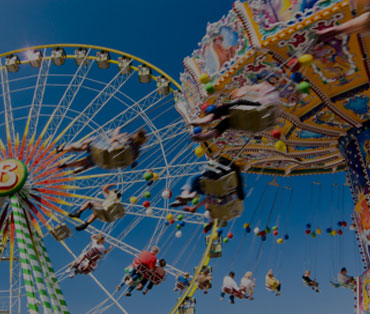Amusement Ride Safety
Safety comes first at Jubilee Entertainment
When families attend fetes, fairs, festivals or special events, the parents have one main consideration: that they are bringing their children into an enjoyable, yet safe environment. At Jubilee Entertainment, the safety of our riders is our number one priority.
During our "off-season" in January/February, Jubilee's full-time service staff work extensively repairing and refurbishing all equipment to ensure they are maintained in first-class condition. Our mechanical amusement attractions are registered with Workcover Queensland, and are annually inspected by fully qualified Structural Engineers. Prior to the commencement of operations at each event, all attractions are carefully inspected by a skilled ride superintendent, with the aid of an inspection checklist.
Not only does Jubilee Entertainment have a comprehensive maintenance and inspection schedule, steps are taken to make certain that each ride attendant is fully trained and knowledgeable in all aspects of amusement operations, safety and cleanliness.
Safety Tips
Before taking your family to a special event where funfair amusements will be present, there's a little bit of thought and planning that can go a long way towards ensuring rider safety and enjoyment. Here are some helpful tips that will assist in making your ride experience safe, pleasurable and lot's of fun.
1. Be selective when deciding which amusements are suitable for your children.
Fairground rides and attractions are great fun for all ages, however not every child will enjoy the bumping, thumping action of the Dodgems Cars, or the stomach-churning orbital rotations of the Round Up. Certain aspects need to be considered before allowing your children, to access amusement rides. This is particularly important for very young children, who cannot read Ride Rule signage; often have no sense of fear; or have little understanding of the consequences of misbehaviour:
- Will your child follow the ride attendants directions?
- Will your child remain seated while the ride is in motion?
- How much experience has your child had with amusement rides?
- Is there a possibility your child will panic due to fear or stress?
- Does your child take risks?
- Will the restraint system on the ride suit your child's body shape and build?
2. Observe the ride in motion with your child before allowing access.
- Read all ride safety signage including minimum height requirements and passenger restrictions.
- Show your children the entry/exit locations.
- Ensure your children know they must remain seated at all times until the ride has come to a complete stop and the ride supervisor releases their restraint.
- Explain to your children what they should do if they become frightened at any stage of the ride sequence. Ensure your children are well aware that under no circumstance should they attempt to leave the ride seat until the attraction has come to a complete stop, and the ride attendant has released their restraint.
- Explain to your children that at some point during the ride they may become scared, though rides are very safe, providing passengers keep their hands and feet inside the seat at all times; hold on tight; and remain seated.
- Tell children to hold on tightly with both hands. Lap bars and handholds are part of the safety equipment. Teach your children to use them.
- Do not encourage your children to put their hands in the air!
3. Follow amusement ride minimum height requirements, age/weight/health restrictions.
- Never try to bypass amusement ride height restrictions. These restrictions were calculated by the designers of the device, and are rigorously enforced by the ride attendants for the safety and well being of the children. If your child does not meet the minimum height requirement of an amusement device, the safety restraint is not designed for your child. By attempting to sneak an undersized or under aged child onto an amusement device, you are placing your child at great risk.
- Amusement rides often have maximum rider height or size requirements, particular smaller rides or larger attractions with over-the-shoulder restraints. If you or your child exceed the Maximum Size restriction of any amusement device - DO NOT RIDE! It's for your safety, the safety of your children, and the safety of other riders.
- If your child does not meet the minimum height requirement of any amusement device, do not ask the ride attendant for some leniency or an "exemption". Explain to your child the reason why they cannot ride, and that it's important in life to always obey the rules.
Safety depends on rider behavior
Research indicates that skylarking and misbehaviour are the main cause of all ride-related incidents. Riders who do not remain in a proper, upright position in their seat; do not follow the instructions of the ride attendant; or deliberately disobey ride safety rules are at extreme risk of being involved in a ride-related accident or injury.
Use all the safety equipment provided
Most mechanical amusement devices that move their passengers in a certain direction, and fitted with at least one rider restraint. The purpose of rider restraints such as Lap Bars, Seat Belts and Over-The-Shoulder harnesses, is to keep the passenger within the seat or carriage at all times, and prevent the passenger from being ejected. Before the ride commences operations, check all restraints to ensure they are properly locked and functioning. Report any concerns to the ride operator immediately.


